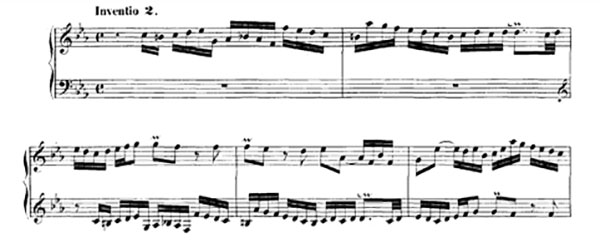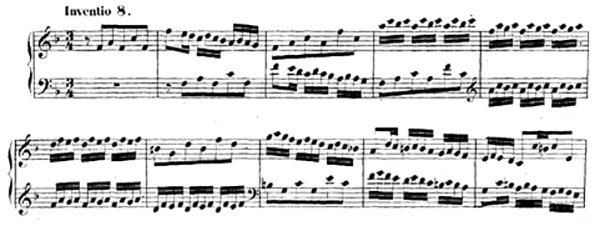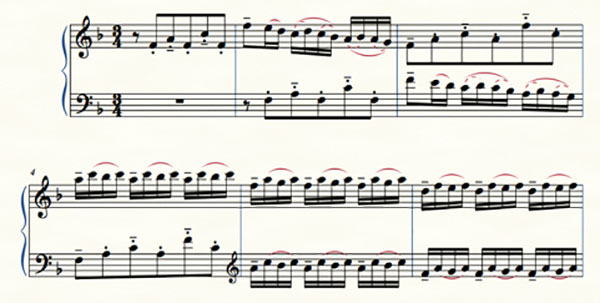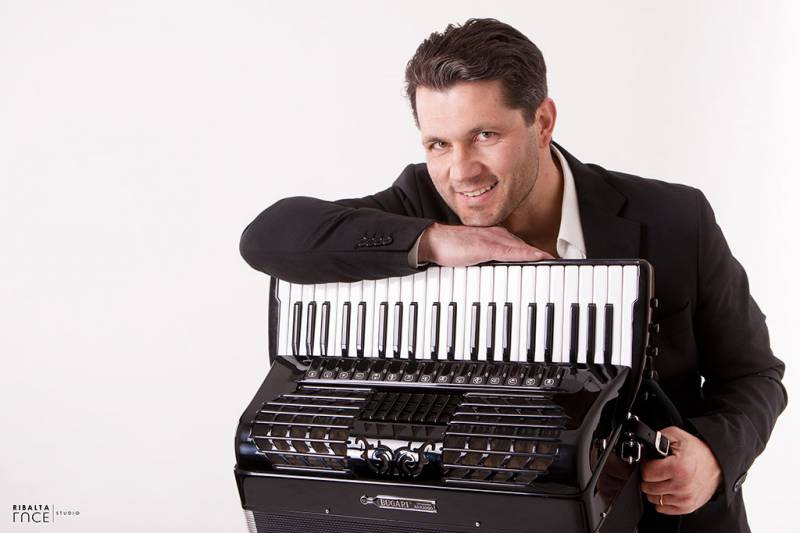Giorgio Dellarole: musica antica per uno strumento moderno – 5 (English version of this article)
L’ARTICOLAZIONE
Il significato del termine “articolazione” è piuttosto controverso. Nell’accezione più stretta si tratta di un artificio tecnico che permette di sgranare le note tramite un’impercettibile separazione tra le stesse, ottenendo quelle che i pianisti definiscono “note sciolte”. È un attributo peculiare della velocità che serve a dare spicco alla singola nota, che non sarà legata alla precedente, ma non sarà neanche staccata. In ambito letterario l’articolazione è rappresentata dalle consonanti che interrompono la continuità delle vocali e così possiamo immaginarla sugli strumenti a tastiera, dove “articolare” potrebbe semplicemente voler dire “introdurre le consonanti”, inserendo quelli che Dom Bedos[1] chiama “silences d’articulation”.
In questo articolo io darò al concetto di “articolazione” un significato più ampio, intendendo con questo termine la maniera di separare i suoni o i gruppi di suoni in qualunque modo e in qualunque contesto.
La fisarmonica ha la possibilità di legare i suoni fino a sovrapporli o di separarli in maniera netta e precisa ed è importante comprendere i criteri che governano queste variabili per poter sfruttare appieno le possibilità del nostro strumento in un repertorio che ha fatto della varietà la propria cifra stilistica.
Abbiamo già discusso ampiamente nei precedenti articoli della scarsità di indicazioni che caratterizza la scrittura musicale sei-settecentesca e delle conseguenti difficoltà che ciò crea agli interpreti attuali e quindi cercherò di affrontare la questione da un punto di vista pratico, senza la pretesa di esaurire l’argomento o di fornire indicazioni categoriche. In ultima istanza dovrebbe essere la musica a suggerire agli esecutori le scelte più appropriate e bisogna sapere che quasi sempre esiste una pluralità di soluzioni ugualmente accettabili se basate sulla conoscenza stilistica e sull’istinto del buon musicista. Mi permetto di ribadire il mio consiglio di non partire dallo strumento, che deve restare uno “strumento”, un tramite tra l’esecutore e il pubblico, ma dalle suggestioni che ci offre il linguaggio.
Analizziamo qualche frammento tratto dalle “Invenzioni e Sinfonie” (comunemente definite “Invenzioni a due e tre voci”) di J.S. Bach che fanno parte del bagaglio della maggior parte dei tastieristi. Le prime indicazioni interpretative sono facilmente accessibili e sono piuttosto interessanti, trattandosi delle parole dello stesso compositore che introducono uno dei due manoscritti autografi[2].
Bach scrive: “Metodo efficace con cui si presenta in forma chiara agli appassionati del clavicembalo (o del clavicordo, ndr) e soprattutto a coloro che sono desiderosi di apprendere, non soltanto come si suona correttamente a due voci, ma anche come si può arrivare, man mano che l’allievo progredisce, a far buon uso di tre voci obbligate e ottenere così non soltanto delle buone invenzioni, ma poterle pure bene eseguire e soprattutto acquistare l’arte del cantabile e il gusto della composizione”.
Nessuna delle 15 Invenzioni e delle 15 Sinfonie contiene indicazioni di movimento e sono scarsissimi i suggerimenti del compositore sulle articolazioni da osservare, ma se Bach si preoccupa di comunicarci che le sue composizioni servono a “soprattutto acquistare l’arte del cantabile”, possiamo dedurre che in generale si dovrà ricercare un tocco morbido e quasi legato che permetta di condurre bene le frasi ed evidenziarne la cantabilità.
A livello pratico e sintetizzando molto i concetti possiamo dire che siano due i parametri fondamentali per la scelta dell’articolazione: il carattere del brano e la distanza tra le note[3].
In una composizione di carattere “cantabile” normalmente si tenderà a legare i suoni; in un brano di carattere brillante il tocco dovrà essere più spiccato e sciolto. Spesso il movimento per gradi congiunti è indicativo di un carattere “cantabile”, mentre l’andamento contraddistinto da salti può suggerire un movimento vivace o di danza.
Se il grado congiunto è un cromatismo e specialmente se questo è discendente si potrà adottare un tocco ancora più morbido e legato.
Naturalmente sono molte altre le variabili in gioco, ma le introdurrò partendo da alcuni esempi.
Il primo riguarda l’Invenzione n.2 in Do minore BWV773
La composizione non riporta indicazioni di movimento.
Possiamo osservare come prevalgano i gradi congiunti, mentre i salti, che pure sono presenti, possiedono quasi tutti un’importante valenza espressiva e non sembrano suggerire un andamento eccessivamente brillante. La tonalità di Do minore è indicativa di un carattere triste e lamentoso[4]. È probabile quindi che la pulsazione sia al quarto.
Suggerisco di utilizzare legature piuttosto evidenti, raggruppando i gradi congiunti e respirando bene per evidenziare la valenza espressiva dei tre salti (Mi bemolle-Sol, Fa-Fa, ma soprattutto la settima diminuita ascendente Si bequadro-La bemolle).
Si tratta di una delle molte possibilità e per ribadire il concetto offro due versioni (non le uniche) della seconda battuta. Nella prima, contrassegnata con la lettera “A” considero che l’ornamento inizi (dal Mib, nota superiore) sul RE (ottavo puntato) sotto l’indicazione “tr” e quindi raggruppo a due a due la quartina precedente e separo l’ornamento stesso da ciò che lo precede (come abitualmente si tende a fare); nella seconda, contrassegnata dalla lettera “B” considero la quartina DO-RE-DO-RE una preparazione dell’ornamento e quindi la raggruppo sotto la stessa legatura che circoscrive il trillo e la sua risoluzione[5].
Il secondo esempio riguarda l’Invenzione n.8 in Fa maggiore BWV779
In questo caso la pulsazione è ternaria e i numerosi salti sembrano indicare un andamento brillante, confermato dalla tonalità di Fa maggiore che spesso è utilizzata per esprimere furia e impeto. La pagina è molto interessante e rappresenta un esempio emblematico di scrittura polifonica sottintesa, che Bach adottò sistematicamente con grande maestria. Si tratta di distanziare le note, facendo intravvedere un rapporto polifonico in una linea melodica. Nella prima battuta la voce superiore è quella che va dal La al Do e al Fa che apre la seconda battuta e la voce inferiore è quella rappresentata dai tre Fa sul primo spazio del pentagramma. Lo schema si ripete nella seconda battuta (pentagramma inferiore), nella terza (superiore), nella quarta (inferiore) e in tutto il resto del brano. Alla quarta battuta, nel pentagramma superiore possiamo nuovamente intravvedere due parti: una rappresentata dai La che aprono ogni quartina e l’altra dai gruppetti di tre note (Do-Si bemolle-Do) che si muovono per gradi congiunti e che sono distanziati di una terza dai La. Naturalmente anche questo schema viene ripreso lungo tutto il corso della composizione.
Io utilizzerei uno staccato piuttosto leggero e secco sulle crome “pari” e uno tocco leggermente più appoggiato sulle crome “dispari” per evidenziarne il diverso “peso” e l’appartenenza a voci diverse (anche se facenti parti di un’unica linea orizzontale)[6]. Raggrupperei le semicrome come indicato, con un andamento a due appena accennato (immaginando l’effetto dell’articolazione di un violino). Dalla battuta 4 separerei le note a distanza di terza, fermandomi leggermente sulla prima semicroma delle quartine e raggruppando le altre tre, che dovrebbero “scivolare” per recuperare il piccolo ritardo accumulato con la sosta sulla prima nota[7].
Con questi due esempi concludo il mio articolo. Mi ripeterò, ma ritengo essenziale ribadire che ciò che esprimo in questi scritti non deve essere inteso come verità unica e perentoria. Esiste quasi sempre una pluralità di soluzioni; l’importante è che poggino sulla conoscenza del linguaggio e sull’analisi della scrittura.
Riprenderò prossimamente il vastissimo discorso sull’articolazione sempre partendo da esempi pratici, che ci offriranno gli spunti necessari ad affrontare le varie problematiche interpretative.
[1] François Lamathe Bédos de Celles de Salelles, meglio conosciuto come Dom Bédos de Celles (1709-1779), fu un monaco benedettino dalle molte abilità: costruttore d’organi, matematico, geometra ed esperto di gnomonica. Il suo monumentale trattato “L’art de facteur d’orgue”, pubblicato dal 1776 al 1778 è ancora attuale presso i fabbricanti di organi [2] Si tratta del manoscritto del 1723 custodito nella biblioteca statale tedesca di Berlino. Un secondo manoscritto autografo, non datato, proviene forse da Köthen. La prima fonte che riporta le Invenzioni è comunque il “Clavierbüchlein für Wilhelm Friedemann Bach” che riporta l’indicazione “iniziato a Köthen il 22 gennaio 1720”, nel quale le Invenzioni sono denominate “Preamboli e Fantasie” [3] Leopold Mozart nella sua “Violinschule”, che ho già citato nei precedenti articoli, scrive: “...quando le note in un’arcata vanno legate e quando devono essere separate? Entrambe le risposte dipendono dalla cantabilità del pezzo e dal buon gusto musicale e, comunque, da un corretto giudizio dell’esecutore... Comunque può servire la regola che le note più vicine tra loro [in altezza] andranno legate tra loro, mentre le più lontane verranno eseguite sciolte...” (cap. IV, § 29) [4] La correlazione tra le tonalità e i relativi caratteri è molto stretta nel repertorio barocco ed è di grande aiuto nella determinazione dell’andamento dei brani. E’ figlia della teoria musicale greca che attribuiva ai diversi modi influenze tangibili sull’animo umano (si pensi al mito di Orfeo che con la sua lira incantava le fiere e animava gli elementi naturali). Esistono molte classificazioni dei caratteri delle diverse tonalità. Citiamo, tra le tante, quella di Marc-Antoine Charpentier nelle “Règles de composition” - 1682?, quella di Johann Mattheson in “Das neu-eröffnete Orchestre” - 1713 e quella di Jean-Philippe Rameau nel “Traité de l’harmonie réduite à ses principes naturels” - 1722 [5] Gli abbellimenti non sono solo i mordenti, i trilli e i gruppetti che abbiamo appreso durante il corso di Teoria e solfeggio, ma sono rappresentati da una moltitudine di simboli che variano a seconda delle epoche e dei compositori. Spesso vengono scritti per esteso e devono essere identificati ed eseguiti correttamente. L’argomento è immenso e lo tratterò ancora ampiamente nei prossimi articoli. Per adesso mi limito a dire che l’abbellimento non ha un carattere “assoluto”, ma va sempre calato nel contesto in cui è inserito [6] Può essere interessante, a questo punto, rileggere il mio precedente articolo dedicato all’accentuazione. Il riconoscimento, all’interno dei brani, dei diversi appoggi del battere e del levare aiuta spesso a comprendere quali note possano essere raggruppate e quali invece vadano separate. A tal proposito ritengo importantissimo prendere in considerazione il significato accentuativo della legatura che separa gruppi di note: la prima nota della legatura è naturalmente portatrice di un accento tonico, non presente invece sulle successive note legate [7] Emilia Fadini e Antonietta Cancellaro nel loro libro “L’accentuazione in musica”, già ampiamente citato e dal quale sono tratte anche le precedenti informazioni sui trattati di Mozart e di Quantz, scrivono che “...pur nel rigore dei tempi della battuta, la prima nota di gruppi regolari interni a singoli movimenti deve essere leggermente allungata rispetto alle altre”. Fanno questa affermazione “sconvolgente”, rispetto alla regolarità meccanica di certe moderne esecuzioni, basandosi su scritti di Johann Joachim Quantz (1697-1773), Carl Philipp Emanuel Bach (1714-1788), Leopold Mozart (1719-1787), Bartolomeo Campagnoli (1751-1827), Carl Czerny (1791-1857) e Ignaz Moscheles (1794-1870), che attestano che il concetto di “compensazione ritmica”, basato sulla regolarità della battuta e guidato dal “buon gusto e dalla sensibilità” ha attraversato i secoli per giungere fino alle soglie del Novecento
Giorgio Dellarole: early music for a modern instrument – 5
THE ARTICULATION
The meaning of the term “articulation” is quite controversial. It could be intended as a technical device allowing to divide notes via an imperceptible separation between them, getting those notes that some pianists define as “note sciolte”. It is a peculiar feature of rapidity, that highlights each single note, which will not be tied to the previous one, but won’t be untied either. In literature, the articulation is represented by consonants that stop the continuity of the vowels; it is pretty much the same thing for keyboard instruments, where “articulate” could simply mean “introduce the consonants”, inserting those that Dom Bedos[1] defines as “silences d’articulation”.
In this article I will give a broader sense to the concept of “articulation”: it will be intended as the manner of separating the notes or the groups of notes in any way possible and in any context.
The accordion has the chance to tie the sounds up to superimpose or separate them sharply and precisely and it is important to understand the criteria that run these variables in order to fully exploit the possibilities of our instrument in a repertoire that has made of diversity its stylistic feature.
In previous articles, we have already extensively discussed about the scarcity of information that characterizes the musical writing of the seventeenth and eighteenth centuries and about the consequent difficulties for current interpreters and so I will try to address the issue from a practical point of view, of course, without claiming to exhaust the topic or to provide a categorical guidance. Ultimately, it should be the music itself to suggest the most appropriate choices to the performers and it is important to know that there is almost always a plurality of equally acceptable solutions if based on stylistic knowledge and on the instinct of the good musician. I insist by saying: do not start from the instrument, which must remain a “tool”, a link between the performer and the audience, but from the suggestions offered by the language.
Let’s scan some fragment taken from “Inventions and Sinfonias” (commonly defined as “Two- and Three-Part Inventions”) by J.S. Bach that are part of most keyboard players knowledge. The first interpretative suggestions are easily accessible and are quite interesting, since the words that introduce one out of two autograph[2] manuscripts are those of the composer himself.
Bach writes: “Honest method, by which the amateurs of the keyboard – especially, however, those desirous of learning – are shown a clear way not only to learn to play cleanly in two parts, but also, after further progress, to handle three obligate parts correctly and well; and along with this not only to obtain good inventions but to develop the same well; above all, however, to achieve a “cantabile” style in playing and at the same time acquire a strong foretaste of composition”.
None of the 15 Inventions and 15 Sinfonias contain a tempo indication and there are very few hints of the composer on the articulations to be observed, but if Bach is concerned to inform us that his compositions are useful to “achieve a cantabile style in playing”, we can deduce that in general it is necessary to look for a soft, almost tied touch that allows to run the phrases and to highlight the lyricism in a proper way.
On a practical level and synthesizing the concepts, we can say that there are two important parameters for the articulation selection: the character of the piece and the distance between the notes.[3]
In a composition of “cantabile” nature, normally, we tend to tie the sounds up; in a piece of brilliant nature, the touch will be stronger and loose. Often the conjunct motion progress indicates a “cantabile” character, while the trend marked by leaps may suggest a lively movement or a dance.
If the conjunct motion is a chromaticism and especially if this one is a descendant chromaticism, it will be possible to adopt an even softer and tied touch.
Of course, there are many other variables involved, but I will introduce them starting from some examples.
The first one concerns the Invention n.2 in C minor BWV773
 The composition does not show any tempo indication.
The composition does not show any tempo indication.
We can observe how conjunct motion prevails, while the leaps, which are also present, almost all have a major expressive value and do not seem to suggest an overly brilliant trend. The tonality of C minor indicates a sad and whiny character[4]. It is therefore likely that we have four quarter beats in a bar.
I suggest to use quite obvious ligatures, grouping the steps and to well breath in order to highlight the expressive value of the three leaps (E flat-G, F-F, but especially the diminished seventh B-A flat).
It is one of the many possibilities, and to reiterate the concept I offer two versions (not the only) of the second bar. In the first one, marked with the letter “A”, I consider that the ornament begins (from E flat, top note) on D (dotted eight note) under the indication “tr” and then I group two by two the previous foursixteenth notes and I separate the ornament itself from what precedes it (as normally done); in the second one, marked by the letter “B”, I consider the beamed sixteenth note C-D-C-D as a preparation for the trill and therefore I group them under the same ligature that circumscribes the trill and its resolution[5]
 The second example concerns the Invention n.8 in F major BWV779.
The second example concerns the Invention n.8 in F major BWV779.
In this case we have a ternary beat and the numerous leaps seem to indicate a brilliant trend, confirmed by the tonality of F major which is often used to express fury and impetus. The page is very interesting and is an emblematic example of implied polyphonic writing, which Bach systematically adopted with great skill. It is about spacing the notes and let see a polyphonic texture in a melodic line.
In the first beat the upper line is the one that goes from A to C and to F that opens the second beat and the lower line is represented by the three F on the first space on the staff. The pattern repeats itself in the second beat (lower staff), in the third (top), in the fourth (lower) and throughout the rest of the piece.
At the fourth beat, in the upper staff we can glimpse again two parts: one represented by the A that opens each quadruplet and the other by groups of three notes (C-B flat-C) which move stepwise and are spaced by a third from the A. Of course, this pattern is used throughout the whole composition.
 I would use a clear “staccato” on “even” eight notes and a slightly more “appoggiato” touch on “odd” eight notes in order to highlight its different “weight” and its belonging to different lines (even if part of a single horizontal line)[6]. I would group the sixteenth notes as indicated, with a slight two trend (imagining the effect of the articulation of a violin). From the fourth beat I would separate the notes at a distance of third, lingering on the first sixteenth note of the quadruplet and grouping the other three, that should “slip” to catch the small delay caused by the stop on the first note[7].
I would use a clear “staccato” on “even” eight notes and a slightly more “appoggiato” touch on “odd” eight notes in order to highlight its different “weight” and its belonging to different lines (even if part of a single horizontal line)[6]. I would group the sixteenth notes as indicated, with a slight two trend (imagining the effect of the articulation of a violin). From the fourth beat I would separate the notes at a distance of third, lingering on the first sixteenth note of the quadruplet and grouping the other three, that should “slip” to catch the small delay caused by the stop on the first note[7].
 With these two examples I conclude my article. I think it is essential to stress that what I express in these articles should not be taken as the only and peremptory truth.
With these two examples I conclude my article. I think it is essential to stress that what I express in these articles should not be taken as the only and peremptory truth.
There is almost always a plurality of solutions; the important thing is that they are based on language knowledge and writing analysis.
I will soon deal again with articulation starting with practical examples, that will offer us some useful ideas to tackle the various issues of interpretation.
(Translated by Marta Cogotti)
[1] François Lamathe Bédos de Celles de Salelles, better known as Dom Bédos de Celles (1709-1779), was a benedictine monk with many skills: organ builder, mathematician, surveyor and sundial expert. His monumental treaty "L'art de facteur d'orgue", published from 1776 to 1778 is still present by the organ manufacturers [2] This is the 1723 manuscript kept in the German state library of Berlin. A second autograph manuscript, undated, comes perhaps from Köthen. The first source that reports the Inventions is however the "Clavierbüchlein für Wilhelm Friedemann Bach" in which is written: "started in Köthen on January 22, 1720", in which the Inventions are called "Preambula und Fantasiae" [3] Leopold Mozart in his "Violinschule", which I have already mentioned in previous articles, writes: "... when the notes in a bowing have to be tied and when they have to be separated? Both answers depend on the lyricism of the piece and on the good musical taste and, anyway, on a correct judgment of the performer... However it is possible to follow the rule that the notes close to each other [in height] will be tied to each other, while the farthest will be run loose..." (Sec. IV, § 29) [4] The correlation between the tonalities and their characters is very narrow in the baroque repertoire and it is of great help in determining the character of the pieces. It derives from the Greek musical theory which attributed to the different modes tangible influences on the human soul (think of the Orpheus myth who, with his lyre, charmed the fairs and animated the natural elements). There are many classifications of the characters of the different tonalities. We mention, among many, the one by Marc-Antoine Charpentier in "Règles de composition" - 1682?, the one by Johann Mattheson in "Das neu-eröffnete Orchestre" - in 1713 and the one by Jean-Philippe Rameau in "Traité de l'harmonie réduite à ses principes naturels" - 1722 [5] The ornaments are not only the mordents, the trills and the turns we have learned during our music theory class, but they are represented by a multitude of symbols that vary, depending on the periods and on the composers. They are often written in full and must be identified and properly performed. The subject is immense and I will deal with it deeplier in the next articles. For now, I will only say that ornament should always be considered in the context in which it is inserted [6] It may be interesting, at this point, to read again my previous article on the accentuation. Recognition, within pieces, of the different pads of “battere” and “levare” often helps to understand which notes can be tied and which ones should be separated. In this regard, it is very important to consider the accentual meaning of ligature that divides the groups of notes: the first note of the slur has a tonic accent, not present on the next tied notes [7] Emilia Fadini and Antonietta Cancellaro, in their book "L’accentuazione in musica", already widely mentioned and from which I took the informations on the treaties by Mozart and Quantz, write that "... in the exacteness of the beats of the measure, the first note of regular groups of beamed notes, internal to single movements, should be slightly stretched compared to the others". They made this "shocking" statement, compared to the mechanical regularity of certain modern performances, basing their thoughts on the writings of Johann Joachim Quantz (1697-1773), Carl Philipp Emanuel Bach (1714-1788), Leopold Mozart (1719-1787), Bartolomeo Campagnoli (1751-1827), Carl Czerny (1791-1857) and Ignaz Moscheles (1794-1870), who prove that the concept of "rhythmic compensation", based on the regularity of the beat and led by "good taste and sensitivity" has spanned the centuries up to the twentieth century





